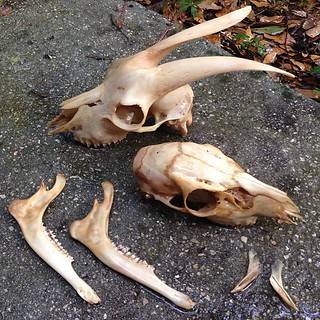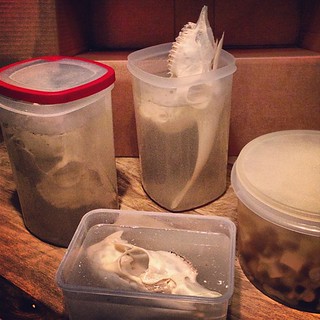
1)
As it started in early March, horn sheaths removed. Added to maceration
tub. Some minor flesh and grease present.

2) Removed from maceration and rinsed, mid April. Had been dumped and refilled once with water.

3) Started hydrogen peroxide bath mid April. No grease present or flesh. Only some bone staining.

4) Done and horn sheaths replaced late April. Turned out gorgeous.


2) Removed from maceration and rinsed, mid April. Had been dumped and refilled once with water.

3) Started hydrogen peroxide bath mid April. No grease present or flesh. Only some bone staining.

4) Done and horn sheaths replaced late April. Turned out gorgeous.

RELATED BLOG POSTS:
Bad Words: BOIL & BLEACH
The Mathematics Of Maceration - A HowTo Guide For The Impatient
Whitening Bone Using Hydrogen Peroxide NOT Chlorine Bleach



9 comments:
Great information...thank you! Just a quick question if I may...what "ingredients " are in your maceration tub?
Literally just tap water, I don't use additives in my maceration process. More on that here:
Bad Words: BOIL & BLEACH - http://bone-lust.blogspot.com/2012/03/bad-words-boil-bleach.html
The Mathematics Of Maceration - A HowTo Guide For The Impatient - http://bone-lust.blogspot.com/2012/05/mathematics-of-maceration-howto-guide.html
Thank you for following up. If I'd been patient I would have found my answer in your vast array of highly informative blogs. I love your approach and will be using it on a first-time project. I was absolutely amazed at how cloudy the water became after just 4-6 hours (hog skull) on what I thought was pretty clean. Thanks again!
Have you noticed that the chemicals in your tap water slow maceration down more than natural waters(lake,river,creek,etc)?
That's a really good question! I'm fortunate to have my own well so I have 100% natural/pure water from the aquifer. But if there was enough pollutants, pesticides or chemicals in the water from a city's tap I imagine that yes, it could cause the maceration bacteria to grow slower or even not be able to live at all. Keeping in mind though that you also do not want some of the things that are in lake water in your maceration tub. I guess try your best to find out what is in YOUR local tap water - http://water.epa.gov/drink/local/
More info about what's can be in urban tap water -
http://www.nrdc.org/water/drinking/uscities.asp
Hi Jana,
I recently acquired an old antelope skull with beautiful long horns, but the sheaths are looking pretty rough. They are incredibly dusty and flaking/cracking in some areas. I tried wiping off a small patch with plain water, and found a lot of brown on the cloth, and the sheath looking quite a bit lighter. (Possibly stained by a previous owner?)
I was wondering if you have any tips for the cleaning and care of horn sheaths.
Any suggestions for this particular situation? Any thoughts on oiling them?
I also wanted to thank you for the very quick response to a question I asked a few months ago. Your input was very useful and very much appreciated. I now have a lovely set of clean and whitened Fisher bones. Thank you!
Alison Welsh, Sorry I really don't know much about polishing/care of horn sheaths at this time. i bet there's tons of info at taxidermy.net though! Good luck, jana
hi, im currently using 3%hydrogen peroxide to whiten my elk skull. ive wrapped it in paper towel and poured the peroxide over it and ill repeat the process. my question is how long should i do this for? ive heard multiple people simply submerging the bones/skulls into the peroxide but this way is also popular. just wondering.
Hi Anna, You're going to want to fully submerge the skull (not the antlers though!) in peroxide. Your current process seems like it may not fully soak into the bone and stay there and may also promote mold growth on the bone.Please not my other blog post - Whitening Bone Using Hydrogen Peroxide NOT Chlorine Bleach - http://bone-lust.blogspot.com/2013/06/whitening-bone-teeth-hydrogen-peroxide.html
Post a Comment